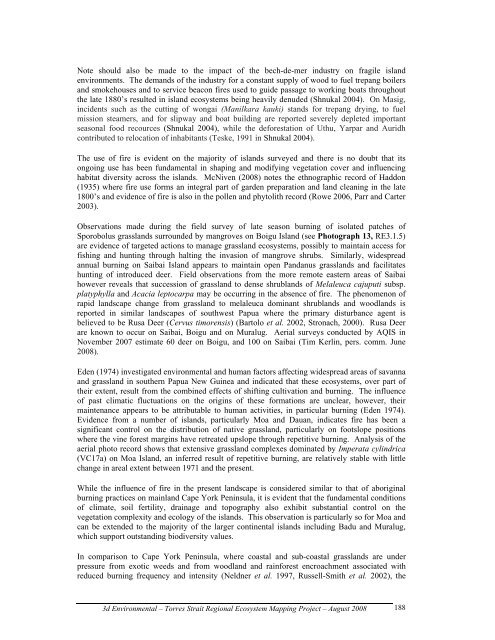Appendix 2 - Vegetation Communities and Regional Ecosystems
Appendix 2 - Vegetation Communities and Regional Ecosystems
Appendix 2 - Vegetation Communities and Regional Ecosystems
Create successful ePaper yourself
Turn your PDF publications into a flip-book with our unique Google optimized e-Paper software.
Note should also be made to the impact of the bech-de-mer industry on fragile isl<strong>and</strong><br />
environments. The dem<strong>and</strong>s of the industry for a constant supply of wood to fuel trepang boilers<br />
<strong>and</strong> smokehouses <strong>and</strong> to service beacon fires used to guide passage to working boats throughout<br />
the late 1880’s resulted in isl<strong>and</strong> ecosystems being heavily denuded (Shnukal 2004). On Masig,<br />
incidents such as the cutting of wongai (Manilkara kauki) st<strong>and</strong>s for trepang drying, to fuel<br />
mission steamers, <strong>and</strong> for slipway <strong>and</strong> boat building are reported severely depleted important<br />
seasonal food recources (Shnukal 2004), while the deforestation of Uthu, Yarpar <strong>and</strong> Auridh<br />
contributed to relocation of inhabitants (Teske, 1991 in Shnukal 2004).<br />
The use of fire is evident on the majority of isl<strong>and</strong>s surveyed <strong>and</strong> there is no doubt that its<br />
ongoing use has been fundamental in shaping <strong>and</strong> modifying vegetation cover <strong>and</strong> influencing<br />
habitat diversity across the isl<strong>and</strong>s. McNiven (2008) notes the ethnographic record of Haddon<br />
(1935) where fire use forms an integral part of garden preparation <strong>and</strong> l<strong>and</strong> cleaning in the late<br />
1800’s <strong>and</strong> evidence of fire is also in the pollen <strong>and</strong> phytolith record (Rowe 2006, Parr <strong>and</strong> Carter<br />
2003).<br />
Observations made during the field survey of late season burning of isolated patches of<br />
Sporobolus grassl<strong>and</strong>s surrounded by mangroves on Boigu Isl<strong>and</strong> (see Photograph 13, RE3.1.5)<br />
are evidence of targeted actions to manage grassl<strong>and</strong> ecosystems, possibly to maintain access for<br />
fishing <strong>and</strong> hunting through halting the invasion of mangrove shrubs. Similarly, widespread<br />
annual burning on Saibai Isl<strong>and</strong> appears to maintain open P<strong>and</strong>anus grassl<strong>and</strong>s <strong>and</strong> facilitates<br />
hunting of introduced deer. Field observations from the more remote eastern areas of Saibai<br />
however reveals that succession of grassl<strong>and</strong> to dense shrubl<strong>and</strong>s of Melaleuca cajuputi subsp.<br />
platyphylla <strong>and</strong> Acacia leptocarpa may be occurring in the absence of fire. The phenomenon of<br />
rapid l<strong>and</strong>scape change from grassl<strong>and</strong> to melaleuca dominant shrubl<strong>and</strong>s <strong>and</strong> woodl<strong>and</strong>s is<br />
reported in similar l<strong>and</strong>scapes of southwest Papua where the primary disturbance agent is<br />
believed to be Rusa Deer (Cervus timorensis) (Bartolo et al. 2002, Stronach, 2000). Rusa Deer<br />
are known to occur on Saibai, Boigu <strong>and</strong> on Muralug. Aerial surveys conducted by AQIS in<br />
November 2007 estimate 60 deer on Boigu, <strong>and</strong> 100 on Saibai (Tim Kerlin, pers. comm. June<br />
2008).<br />
Eden (1974) investigated environmental <strong>and</strong> human factors affecting widespread areas of savanna<br />
<strong>and</strong> grassl<strong>and</strong> in southern Papua New Guinea <strong>and</strong> indicated that these ecosystems, over part of<br />
their extent, result from the combined effects of shifting cultivation <strong>and</strong> burning. The influence<br />
of past climatic fluctuations on the origins of these formations are unclear, however, their<br />
maintenance appears to be attributable to human activities, in particular burning (Eden 1974).<br />
Evidence from a number of isl<strong>and</strong>s, particularly Moa <strong>and</strong> Dauan, indicates fire has been a<br />
significant control on the distribution of native grassl<strong>and</strong>, particularly on footslope positions<br />
where the vine forest margins have retreated upslope through repetitive burning. Analysis of the<br />
aerial photo record shows that extensive grassl<strong>and</strong> complexes dominated by Imperata cylindrica<br />
(VC17a) on Moa Isl<strong>and</strong>, an inferred result of repetitive burning, are relatively stable with little<br />
change in areal extent between 1971 <strong>and</strong> the present.<br />
While the influence of fire in the present l<strong>and</strong>scape is considered similar to that of aboriginal<br />
burning practices on mainl<strong>and</strong> Cape York Peninsula, it is evident that the fundamental conditions<br />
of climate, soil fertility, drainage <strong>and</strong> topography also exhibit substantial control on the<br />
vegetation complexity <strong>and</strong> ecology of the isl<strong>and</strong>s. This observation is particularly so for Moa <strong>and</strong><br />
can be extended to the majority of the larger continental isl<strong>and</strong>s including Badu <strong>and</strong> Muralug,<br />
which support outst<strong>and</strong>ing biodiversity values.<br />
In comparison to Cape York Peninsula, where coastal <strong>and</strong> sub-coastal grassl<strong>and</strong>s are under<br />
pressure from exotic weeds <strong>and</strong> from woodl<strong>and</strong> <strong>and</strong> rainforest encroachment associated with<br />
reduced burning frequency <strong>and</strong> intensity (Neldner et al. 1997, Russell-Smith et al. 2002), the<br />
3d Environmental – Torres Strait <strong>Regional</strong> Ecosystem Mapping Project – August 2008<br />
188


